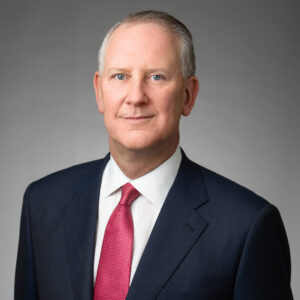AIG is “a different company” today than it was when CEO Peter Zaffino joined the company in 2017, but like the old AIG, the new one is poised to grow again, he said.
The former executive of Marsh, who recalled that during his tenure at the broker he would place business with AIG’s Lexington Insurance only as a last resort, is bullish on the prospects of growing the E&S business written in Lexington, and the company overall, now that remediation of a business is a done deal.
Zaffino, who confirmed that growth efforts started two years ago, described AIG’s trajectory and the state of the E&S market during a fireside chat with Autonomous Research Insurance Analyst Ryan Tunis at a fireside chat at Bernstein’s 40th Annual Strategic Decisions Conference this week.
“I knew AIG really well. I was at Marsh & McLennan for 17 years, and they were our biggest trading partner…..It was known as a growth company, not necessarily a great underwriting company,” Zaffino said, explaining to Tunis how AIG is now maintaining underwriting discipline as it moves back into growth mode.
“Underwriting discipline is really driven by the culture and the framework and who you have leading the businesses,” Zaffino said, reporting that leaders holding 17 of the top 20 underwriting positions at AIG today have less tenure than Zaffino, who first joined AIG in July 2017 as global chief operating officer.
“We had to have a culture of underwriting excellence, have a chief underwriting office that was not a tick the box, but actually was setting standards, monitoring growth and also profitability—and having underwriting guidelines that we’re going to be aligned with how we wanted to shape the portfolio.”
“We’ve done the hard work of repositioning the company in terms of its underwriting standards and underwriting results, and it’s been a significant heavy lift,” he said.
“Just to level set—I’ve said this before, the [AIG] portfolio from 2008 to 2018 lost $30 billion. That has not been done in our industry and you survived,” he said.
“The portfolio which we had to remediate was a highly unprofitable portfolio,” he said.
“From 2018 to ’23, the calendar year commercial lines combined ratio improved by 2,600 basis points, which is dramatic,” he said, referring to a downward move of 26 combined ratio points. “The accident year combined ratio, which is just really the results in that year with no effect of catastrophe or prior year reserve development was 1,900 basis points,” he said.
“If I leave you with one thing today, [it] is that this is a different company. There’s really no way to look into the past of anything of relevance to today,” he said, while referencing AIG’s great brand, good global presence and ability to grow.
Vive La Différence
In the first four minutes of a 45-minute session, Zaffino rattled off a long list of differences, explaining successful efforts to shed volatility in the insurance portfolio, reduce expense in AIG’s operations and to divest of businesses, like the reinsurance business, where AIG didn’t have the size and scale to drive outcomes in the market.
As evidence of the reduced volatility, he noted that catastrophes added only 4.7 points to the loss ratio in 2023, compared to 16 points in 2017.
On the expense side, Zaffino noted AIG simultaneously embarked on a transformation of its operational capabilities while implementing an underwriting turnaround. “It was $1 billion of savings,” he said, referring to the outcome of a transformation effort known as AIG 200. “But what I’d like to leave you with is, more importantly, it was really a big improvement in terms of data, data ingestion, workflow, digital workflow, cloud migration and just improving the core foundation for AIG in the future,” he said.
Zaffino expanded on these efforts during the rest of the session in response to questions from Tunis about internal and market challenges moving forward, with Zaffino, at several points, delivering critical comments about the AIG he knew as a broker before he joined the company.
Tunis, for example, noting how much smaller AIG is now than a decade ago, asked whether less market clout now would pose challenges to growth in future years.
“No. If you go back in time, when AIG was at its peak, probably $65 billion of top line, it squandered that opportunity,” Zaffino said, noting that AIG back then was bigger than any broker. Today, AIG writes roughly $35 billion of gross premium, and Marsh and Aon probably place three- or four-times that, he suggested.
“What AIG had as an unbelievable advantage at that time, just wasn’t taken advantage of,” he said.
Addressing the challenge question directly, Zaffino said, “size matters, but I think what matters more is where you trade….Are you setting the underwriting terms? Are you setting the pricing? Are you the one that has the lead capabilities, which means you have the underwriting expertise?”
“That’s the businesses we trade in. We’re not a capacity player that tries to find risks through an open market and best price wins. That’s a failed strategy.”
Echoing comments he had made at prior investor conferences, Zaffino talked about a different failed strategy—a prior strategy at AIG which had the specialty insurance operation, Lexington, placing business through both retail brokers and wholesalers.
Related article: Wholesale Growth Is Cycle-Proof; Dual Distribution Has Failed: AIG’s Zaffino (2022)
“That is a terrible strategy and one that ends up getting adverse selection everywhere,” Zaffino said.
“Retail brokers don’t want to go to excess and surplus lines markets…..I ran Marsh, and I’m telling you, I didn’t want to go to Lexington. It would be the market of last resort in every instance.
“Wholesale doesn’t want to use a market that will use retail. So they give you the adverse selection.
So it ended up becoming a giant business of adverse selection, plus why not just like issue the largest limits you can to make sure that the results are even worse?” he asked rhetorically, referring to the fact that AIG would put out $100 million prior to the underwriting transformation.
“If I look at the market share under that strategy, it was three-times the size that we are today. So, I would argue that we have plenty of room to grow,” he said, addressing a possibility raised by Tunis that there hasn’t been a secular shift in market volumes to the E&S market as Zaffino and others bullish on the sector believe, but instead that E&S growth will return to a classic cycle—good in hard markets, and tough in soft markets.”
“How much of an impediment would that be for AIG?” Tunis asked, a few minutes after Zaffino described AIG’s disproportionate investment in the last two years into areas of high-growth potential and strong combined ratios—such as Lexington E&S—while still remediating always the bottom portion of the portfolio.
E&S: ‘Not Going to Give A Lot Back’
“It won’t be an impediment at all. [First], I don’t believe it,” said Zaffino referring to the idea of a return to classic cycle in which E&S grows only during the hard part of the cycle.
Zaffino said that E&S has grown substantially over the last 20 years, noting that the E&S market commanded $34 billion of premium in 2003 and 2004, and now represents roughly $114 billion. (Editor’s Note: The latest figure for the size of the E&S market that CM has reported on is $91 billion for 2022, based on a report from Fitch Ratings published in September 2023. Related article, “Top 15 E&S Writers: Lloyd’s, Berkshire Still Lead as All Major Players Grow“)
“It’s grabbing market share. There’s no doubt about it. Their capabilities are broadening and their ability to actually drive outcomes is substantial. Look at [wholesale] organic growth versus retail and they have the momentum.
Referring specifically to AIG, Zaffino noted that since leaders decided to ditch the dual distribution strategy—”which means we had to basically non-renew most of the portfolio, turn it over and go through wholesale—the compound annual growth rate from ’17 to ’23 is 20 percent in wholesale. It’s never been that large. And we’re talking off of bigger bases now,” he said.
Expressing disbelief in the idea of hard market-soft market cycle driving industrywide E&S growth or contraction going forward, Zaffino said supply issues have historically fueled hard markets, such as the post 9/11 hard market. “There’s no shortage of capacity in the marketplace. We could write billions of dollars of premium if they have the right risk-adjusted returns, as could many of our competitors,” he asserted.
Zaffino also noted the record-breaking submission levels coming into wholesalers quarter after quarter, and also suggesting that there may be 80 wholesale-only insurance company markets in existence today (some doing fronting) vs. only eight or nine when Lexington announced its shift to wholesale-only.
“I don’t see it,” Zaffino said, reacting to the supposition from Tunis that a cycle could shift the momentum of the E&S market. “If you go back to that period of time, when I said it was back to $34 billion, it lost a little bit of market share in the more traditional hard market-soft market. But it’s not going to give a lot back this time.”
Nonetheless, Lexington isn’t AIG’s only insurance company. “I’ve got plenty of admitted capabilities. I’m not plugging for it. I just think [E&S] is where the market is. And so if it doesn’t work, I’ve got like other businesses that can pick up the opportunities. This is not we’re wholesale-only, and we’re betting in the farm. I just think there’s plenty of opportunities for Lexington to grow. I think that market is going to grow,” he said.
Softer Hard Market: Who Cares?
Tunis asked Zaffino about market conditions overall, and the sustainability of hard market pricing.
“If you’re still getting rate increases, but you may not have gotten rate increases as [high] as you got last quarter, who cares? I don’t,” Zaffino said. “I’d like to have it. But what I want is to make sure that we continue to develop margin. We retain the book of business…..If I got it like a 30 percent [rate increase] last year and a 10 this year, and the 10 is above the loss cost increase, that’s a good outcome.
“I just don’t want to look at the sequential rate increases,” he said, adding that “in some of our businesses, in quite frankly, a lot of them we’ve gotten north of 100 percent rate increases [cumulatively] over the past 4-5 years.”
Speaking about property specifically, Zaffino predicted a stable market but noted possible impacts on carriers who attempted to fill in reinsurance programs with collateralized reinsurance when admitted reinsurers “moved away from risk dramatically” during Jan. 1 renewals in 2023, forcing higher retentions.
While admitted reinsurers automatically reinstate limits in the event of catastrophe, “collateralized reinsurance doesn’t work that way. It’s a single limit. It blows out, it’s gone and you have no reinsurance left,” he said. “You have a lot of the buydowns that were done in order to supplement those attachment points—done by collateralized reinsurance [that] can blow out with one major loss.”
He continued, “I don’t know what’s going to happen this year, but if it’s very active, you’re going to have big net positions in the business,” he said, referring to the active hurricane season that meteorologists are predicting. “That’s going to affect how capital is deployed in my opinion,” he said.
AIG Next
During the session, Zaffino gave some further visibility into the operational transformation, AIG 200, and a briefly referred to a follow-on program, AIG Next, which he described as “an expense initiative to start to take a company that was a conglomerate and put it into a single company.”
In a letter to shareholders in the AIG 2023 annual report, Zaffino said that the aim of AIG Next is to create “a leaner parent company with a target cost structure of 1-1.5 percent, while further positioning AIG for the future by operationalizing enterprise-wide standards and driving global consistency and local relevance across our end-to-end systems.”
Simplification and efficiencies from AIG Next are expected to generate $500 million of annual run-rate savings, the letter said.
Tacking the $500 million on to the $1 billion savings from AIG 200, Tunis asked Zaffino whether he envisioned that magnitude of savings early on in his AIG tenure.
Zaffino said the AIG 200 savings were really an end result of work necessary operational fixes. “Whether it was cloud computing or end-to-end process, it was a very broken process within the underwriting—how you get submissions, how you actually work through the rating mechanisms, he said, noting inconsistency throughout the organization.
“In many ways, I think that was more cultural shock to AIG than underwriting [transformations]. At least we had underwriters. It wasn’t very good, but there was underwriting going on.”
“In operations, there was nothing. So, we had nothing to compare it to,” he said.
Topics Excess Surplus AIG
Was this article valuable?
Here are more articles you may enjoy.




 ‘Extremely Dangerous’ Hurricane Beryl Takes Aim at Caribbean
‘Extremely Dangerous’ Hurricane Beryl Takes Aim at Caribbean  Allstate, Nationwide Post Dramatic Q12024 Homeowners Loss Ratio Drops: S&P
Allstate, Nationwide Post Dramatic Q12024 Homeowners Loss Ratio Drops: S&P  US Roof Maintenance Lags: Hanover
US Roof Maintenance Lags: Hanover  Changes at American Coastal Insurance After Florida OIR Action on ‘No-Fly List’
Changes at American Coastal Insurance After Florida OIR Action on ‘No-Fly List’ 


